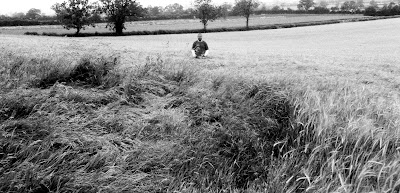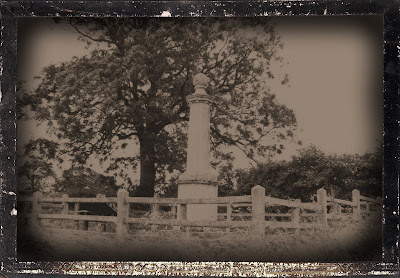 From a young age I’ve always enjoyed “period” films depicting events from an earlier, more colorful time. The style of speech, the battle scenes and the depiction of life from lowly serf to highest royalty fascinated me and "Cromwell" had it all, including a “live” depiction of a royal execution! What eight-year old boy could pass that up?
From a young age I’ve always enjoyed “period” films depicting events from an earlier, more colorful time. The style of speech, the battle scenes and the depiction of life from lowly serf to highest royalty fascinated me and "Cromwell" had it all, including a “live” depiction of a royal execution! What eight-year old boy could pass that up?Many years later I was an invited guest to a Highlander’s Wedding in Daventry, Northamptonshire, about 80 miles northwest of London. In the "Pancreas" of England between Birmingham at the west, Stratford-Upon-Avon to the south and Leicester to the northeast lay the birthplace of rugby, Warwick Castle and the Roman Road of “Watling Street.” Most exciting of all to me, however, was the Battlefield of Naseby only 15 miles from the site of the wedding!
In June of 1645 the “unthinkable” English Civil War had been raging for nearly three years and things were starting to turn against the crown. King Charles I (played in the film by Sir Alec Guinness seven years before Obi Wan),was heading south to his base at Oxford following a costly victory at Leicester when he was flushed out by the Parliamentarian “New Model Army” racing northward under Sir Thomas Fairfax to catch him. Unable to meet up with reinforcements from Wales and Somerset, Charles swung back north to regroup at Newark but was forced to turn and fight on the fields of Broad Moor at Naseby.
Oliver Cromwell (a scene chewing Richard Harris) ma
 de light work of Sir Langdale, his direct opponent on the King’s left. He then charged to the west through the weakened center of the Royalist infantry towards the remaining cavalry of Prince Rupert (a scene stealing Timothy Dalton) on the King’s right, routing the royal army in short order, just as he had done the year before at Marston Moor.
de light work of Sir Langdale, his direct opponent on the King’s left. He then charged to the west through the weakened center of the Royalist infantry towards the remaining cavalry of Prince Rupert (a scene stealing Timothy Dalton) on the King’s right, routing the royal army in short order, just as he had done the year before at Marston Moor.The film that I first saw as a boy covered nine years of British history in under three hours. The Battle of Naseby itself lasted about as long.
Few historical films are ever 100% accurate and “Cromwell” is loaded with inaccuracies and blatant omissions but it hardly mattered to a mesmerized eight-year old. One thing is certain: Charles lost the war and ultimately his own head, the only sitting monarch in English history to be executed. It ran in the family: his grandmother was Mary, Queen of Scots. To this day, however, he maintains a loyal following of supporters.
This is not an American Civil War battlefield. On the edge of an unremarkable field stands a weather-beaten monument that s
 eems cast aside, woebegone and misplaced but in truth marks the center of the “Roundhead” Parliamentary line. No manicured green space, tour bus parking lot ringed with gift shops and cafes, "timeline trails" stuffed with placques and markers detailing what happened "at this very spot" or guides to retell the tale. There’s not even a McDonald’s; just an open field gently sloping downward beside a quiet country road before rising again barely a half-mile away at Dust Hill where the Royalist army was positioned on the northern ridge.
eems cast aside, woebegone and misplaced but in truth marks the center of the “Roundhead” Parliamentary line. No manicured green space, tour bus parking lot ringed with gift shops and cafes, "timeline trails" stuffed with placques and markers detailing what happened "at this very spot" or guides to retell the tale. There’s not even a McDonald’s; just an open field gently sloping downward beside a quiet country road before rising again barely a half-mile away at Dust Hill where the Royalist army was positioned on the northern ridge.The entire area is pregnant with silence, the Sulby Hedges at the western edge of Broad Moor field are the lone surviving witnesses, resolutely maintaining a 360 year covenant with the stillness. Where buglers sounded, calling to nameless and forgotten men at odds, today hardly even the winds remain.
At least it is still there. If every battlefield in England were preserved there’d be no living England to speak of. Yet for as much fighting that has taken place on and above British soil only the Battle of Hastings in 1066 and the Battle of Britain ever garner much in the way of conscious thought. Naseby in comparison may as well have not happened at all.
In the grand scheme of things Naseby merely started the transition from monarchial to parliamentary rule, little more than the natural evolution of government in one country among many. Right. And nothing much ever really came from the Battle of Yorktown either.
Gotta go.
No comments:
Post a Comment